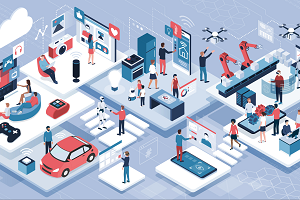IoT-powered RTLS – The future is now

Regardless of what sector your organisation operates in, be it retail, manufacturing, logistics, healthcare, or sport, you will be affected by the wave of digital transformation sweeping the business world. One of the main drivers of this has been the growthof IoT or internet of connected devices.
The number of IoT devices reached 23.1 billion in 2018 and is expected to grow to 30.7 billion this year hitting 75.4 billion in 2025. Throw in the growing global deployment of 5G, where it is estimated that one million 5G (IoT) devices will be able to fit in a square kilometre, and it is clear that we are heading towards a world of multiple real-time touch points leading to even more readily available data about people and products, says Fabio Belloni, CCO and cofounder of Quuppa
In general, IoT devices are mobile, detecting the surrounding environments or interacting with nearby devices as they are moved around. As such, the recorded information is of great value, but its usefulness is limited without knowing where the device is at the time of recording. In other words, it is the combination of both the content and contextual information that makes data truly rich.
Real-time location systems (RTLS) focus on detecting the location of a target, anything from a vehicle to a package to a person. Such systems consist of wireless nodes typically tags or badges that emit signals to connected devices, providing accurate real-time data on processes.
The merging of RTLS and IoT has created a new ecosystem that can provide healthcare facilities, private business and more with numerous advantages. These advantages include the integration and automation of systems and assets, workflow management, safety enhancements, and the collection of impartial and accurate data.
Furthermore, many handheld devices already include the components needed to enable location tracking. With a software update, these devices can be upgraded to unlock the potential of IoT powered RTLS seamlessly and cost effectively. This can be seen in the use of a visitor’s mobile phone as part of the venue experience in a museum, the increasing popularity of barcode scanners for efficient grocery shopping and industrial barcode scanners used by logistics workers.
Another benefit is management processes within manufacturing and logistics industries. For example, by combining the two technologies, a foreman or site manager can continuously collect and log information from readers and tags located all around the site.

Fabio Belloni
With data constantly being taken from workers and equipment tags, it can be gathered and sent to a mobile device or PC, allowing management to collect detailed, real-time, accurate reports across a number of different areas.
Imagine knowing exactly where a piece of equipment was in a large industrial warehouse, or having the ability to track what work is being carried out and where, as well as the health and safety statuses of key assets?
The potential extends to labour, one of the biggest expenses of any business, as managers can now manage workflows, overtime, capacity and more. Combining RTLS with IoT in these industries means real-time insights, improved job site safety, and reduced costs through streamlined workflows, organisation and management.
IoT and RTLS can also work together to improve return on investment and deliver efficiencies. Healthcare is one of the sectors that best illustrates this potential. Reductions in the time to identify the cause of a symptom or to locate an important device or critical medication can be the difference between life or death. In addition to supporting the best care in those critical moments, IoT enhanced RTLS is enabling better, more individually tailored services, while saving hospitals significant amounts of money.
Not only this, but it allows hospitals to increase the efficiency of care, freeing up valuable time for their patients and achieving other key objectives by improving the tracking and management of assets, processes and compliance to regulatory standards.
The combination of RTLS solutions and IoT provide hospitals and other healthcare facilities with numerous advantages, including integrating and automating healthcare systems (such as EMRs), automating asset, patient and staff workflows, enhancing patient and staff safety, monitoring hygiene compliance, collecting impartial, accurate patient data and data on care milestones.
As seen in the above examples, IoT combined with RTLS has the potential to become the foundation for applications that boost efficiency, productivity and safety in every industry you can think of. The ability to accurately locate and track both assets and people allows processes to be optimised and helps employees to focus on activities that bring more value, efficiency and cost savings to the organisation; forming the basis of a long list of business-critical operations. Businesses are now beginning to adopt these two innovations in their regular work processes to make work environments more secure, intelligent, and profitable than ever before
The author is Fabio Belloni, CCO and cofounder of Quuppa
Comment on this article below or via Twitter @IoTGN
